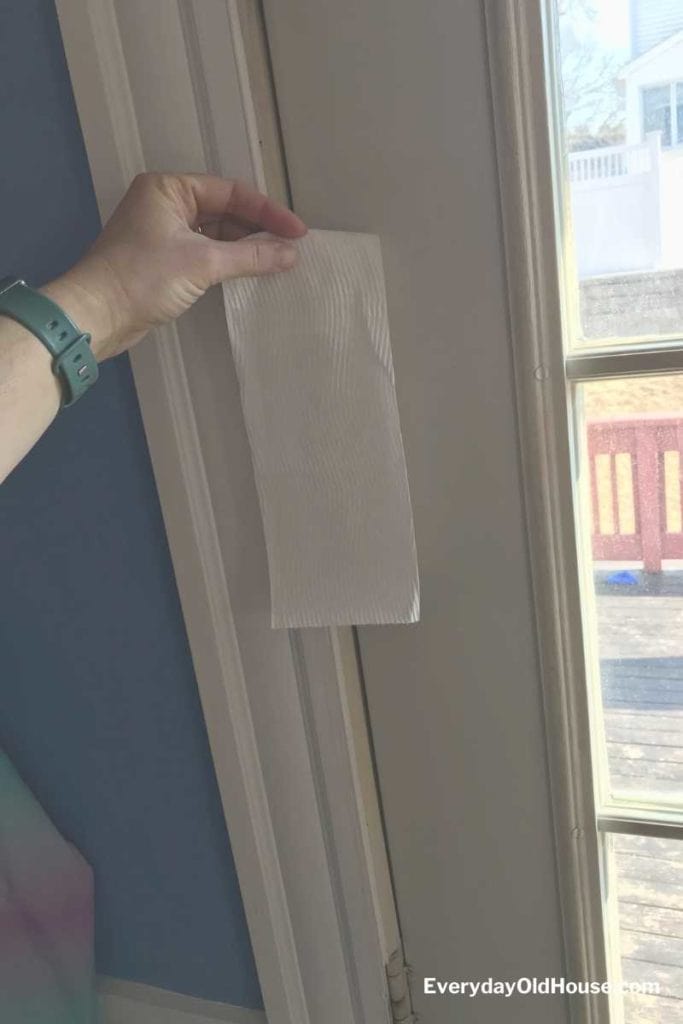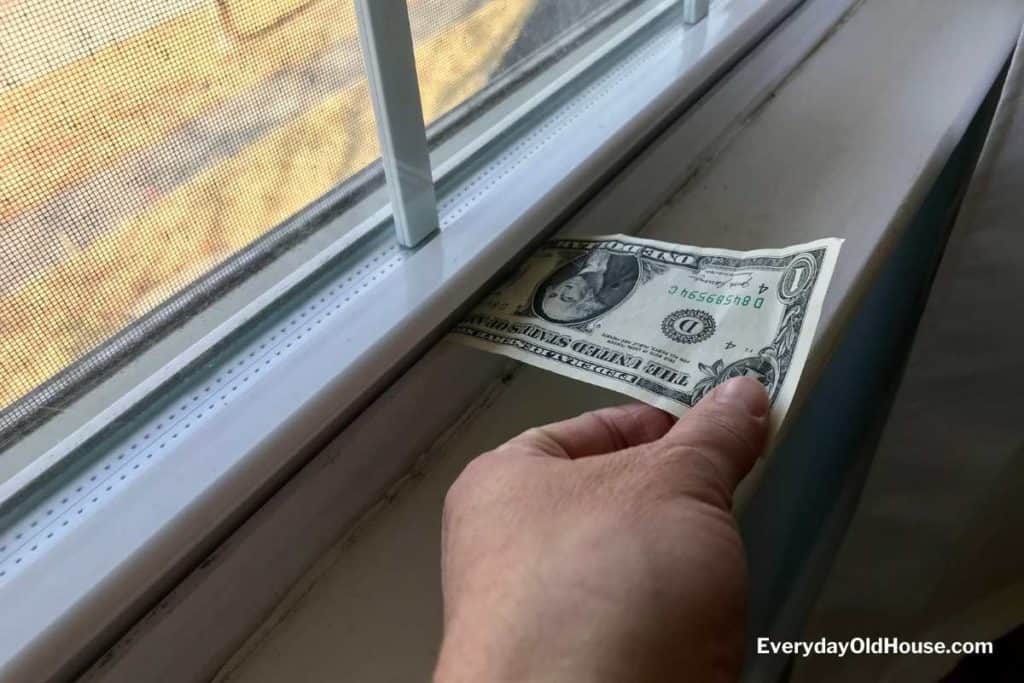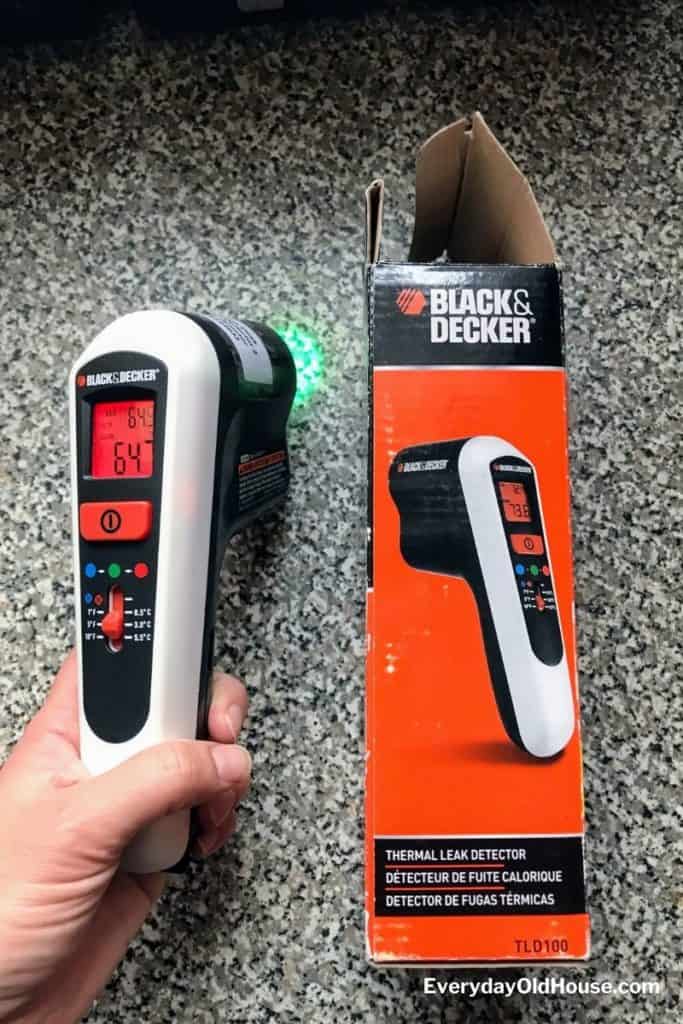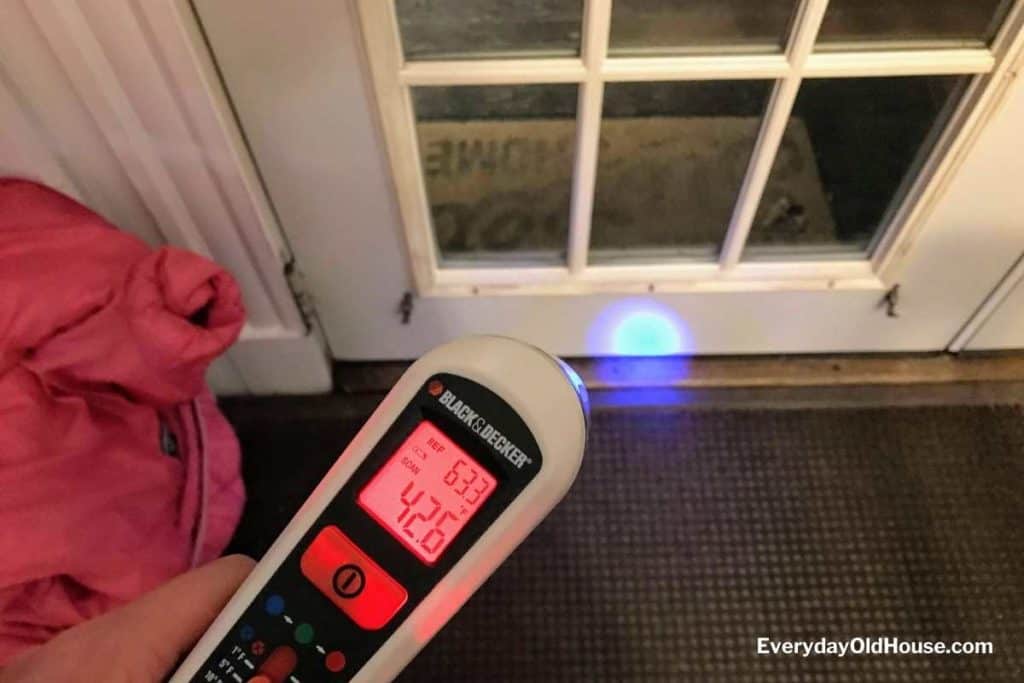Last Updated on December 5, 2023
Feeling a bit uncomfortable and chilly inside your home during winter? Yup, me too. If so, our homes have gaps where cozy warm air heads straight to the great outdoors. While there are numerous places susceptible to air leaks, a common culprit are windows and doors. Let’s jump into some free ways to detect drafty windows and doors.
These methods will quickly (and for free!) pinpoint the spots where warm air is escaping so you can seal up your house – and save money.

My Experience
Recently, many homeowners, including myself, have been grappling with soaring energy bills. Blame it on global supply volatility or supply chain issues, but the fact remains – utility rates are on the rise.
Faced with a jaw-dropping heating bill, I decided it was high time to explore ways to enhance our home’s energy efficiency and stretch our budget. A noticeable chill in our living room, especially near the large picture window and front door, prompted me to investigate potential drafts in our home.
Here’s what I found….
Common Sources of Air Leaks in Homes
Unfortunately, air leaks occur anywhere and almost everywhere in your house. According to US Department of Energy, the most common sources of air leaks are:
- Fireplaces
- Window and door frames
- Electrical and gas service entrances
- Electrical outlets
- Baseboards
- Attic hatches
- Wall- or window-mounted air conditioners
- Cable TV and phone lines
- Dryer vents
- Recessed lighting
- Mail slots
- Pipe vents
Geez Louise, that’s a lot of areas? A bit overwhelming, right? But if homeowners take a few simple, inexpensive measures to properly seal and insulate our homes, we can potentially save as much as 15% on cooling and heating bill.
Considering our outrageous energy bills this past month, I’m interested in any inexpensive ways to seal up our house that could lead to savings back in our pocket.
Sealing Drafty Windows & Doors is Inexpensive
Windows and doors, comprising about 20% of heat loss in homes, play a crucial role in energy efficiency. Unlike other problem areas such as attics, fixing air gaps in windows and doors is a simpler, faster, and more cost-effective solution to prevent cold air from infiltrating your home.
In our pursuit of an energy-efficient home, let’s focus on the “low-hanging fruit” – sealing drafty windows and doors.
Old Windows & Doors
As the owner of an Everyday OLD House, I understand the unique challenges of drafty windows and doors in older constructions. The lack of modern insulation and weatherproofing, along with aging sealants, often leads to increased air gaps.
However, the good news is that studies have shown properly maintained old windows can be just as effective as new ones, even providing energy efficiency in single-pane windows. New windows is not the only option.
So, before considering an expensive window replacement, read more at the Window Preservation Alliance and The Craftsman Blog.
8 Free Ways to Detect Drafty Windows & Doors
Before you can start sealing up your house and removing air leaks, first you must identify where the heat is being lost. For windows, cold air seeps in through both the the glass window panes (especially single panes) and well as through the frames. For doors, it’s usually just the frames (unless the door material is actually compromised).
Here’s a few simple and free ways to find leaky windows and doors.
1. Take a “Look-See”
Begin with a visual examination of window and door frames. Search for visible cracks, gaps between frames and house siding, or damaged caulking and weather-stripping. Old windows, in particular, may exhibit signs of wear, making this step essential.
In addition to inspecting around the door and window frames, check the actual window panes and door. For example, if you have older windows consisting of individual panes of glass, inspect each window pane for damaged glazing. Inspect material for any splits or cracks. For example, when we moved into our home 10 years ago I quickly saw daylight peeking through our wooden front door.
2. Touchy Feely
Like the old Arid deodorant commercial from the 1980s – “Get a little closer, don’t be shy”.
On a cold or windy day, run a damp hand around windows and doors to detect drafts. Lightly push and pull windows to identify rattling, signaling potential air leaks. This tactile approach provides a hands-on understanding of the cold air infiltrating your home.
Why a damp hand? With drafts, you will feel a colder temperature and easily to identify areas where cold air can sneak inside.
3. Smoke Test
For a more sophisticated approach, try a DIY “building pressurization test”, also known as a smoke test. In basic terms, this test creates an environment that increases the infiltration of air through the cracks in your house. It magnifies the cold drafts in your windows and doors making them more easily identifiable.
Smoke Test Instructions
- Choose a windy day.
- Turn off all appliances that create air disturbances, such as furnaces, water heaters, or radiators.
- Turn on all exhaust fans, such as clothes dryers, bathroom fans and stove vents. If you want to get cray, use a big window fan to suck air out of the house.
- Shut all windows, exterior doors and fireplace flues.
- Light a candle, incense stick, etc. Slowly and carefully move it around your window and doors.
If the flame or smoke moves unsteadily (sucks into or out of the room, etc… then you’ve found a source of cold air!

If you don’t want to use a candle or incense (and willing to spend the money) there are professional smoke pencils that can be used as air leak detectors. But this post is entitled “free ways”.
4. Toilet Paper
Personally this method to detect drafty window and doors makes me chuckle. It reminds me of those younger days of TP-ing a house on Halloween. (Which of course I NEVER did. Mom – I hope you aren’t reading this post ?)
Hold a piece of paper or toilet paper around window and door frames. If it wavers, indicating an air leak, you’ve found a draft. This method is particularly effective for detecting smaller leaks that may go unnoticed with other materials.

5. Dollar Bill
Place a dollar bill in a closed door or window. If you can easily pull it out without resistance, there’s a draft. This simple yet effective test requires only a dollar bill and helps pinpoint air leaks.

7. Thermal Leak Detector
Did you know that some libraries lend more than books? My local library has a “Library of Things”, including telescopes, soil meters and (drum roll please….) thermal leak detectors!
Amazingly awesome, right?
Simply scan the thermal leak detector around your windows and door. This infrared technology visually displays cold spots in blue, guiding you to areas where drafts are present.
My library’s Black and Decker’s thermal leak detector showed me exactly where the drafts were coming into our home. Super easy.

Weirdly, it was fun to use. Ultimately, I scanned the whole house – floors, walls, attic hatches, etc… And unfortunately, found several cold spots in our walls, which indicates poor insulation in the wall cavities. Sigh….

8. Energy Audit
Contact your local energy supplier for a free energy audit. These audits, often provided at no cost, can pinpoint drafty windows and doors while offering valuable recommendations for improvements. Take advantage of this professional assessment to enhance your home’s energy efficiency.
A major component of these audits is pinpointing drafty windows and doors.
When we first moved into our house 10 years ago we signed up for a free energy audit. Not only did it help pinpoint where we should start our improvements, we also received rebates and credits on our energy bill after we completed these upgrades (Yippee! More money saved!)
Next Step
Living in a drafty house is not only uncomfortable but also painful to your wallet. Identifying where those drafts are, and applying easy, inexpensive fixes (future port) will keep your home warm and toasty and be gentler on your wallet.
Sealing drafts doesn’t have to break the bank. Explore inexpensive fixes such as draft snake, draft stoppers, or window plastic with double-sided tape. These simple measures can make a significant impact on your home’s comfort and energy bills.
Related Posts
Want to be the first to know about new posts? Be sure to follow me on Pinterest, Facebook, Instagram or Twitter of even Etsy! Or better yet… Subscribe below!
My monthly (admittedly sometimes more, sometimes less….) emails are like receiving a unexpected letter from an old friend WITHOUT needing to put on your slippers and walk out to your mailbox…. See? I got ya, my friend!)
[Note: My posts are proudly connected to these amazing link parties full of DIY ideas and inspiration!]


